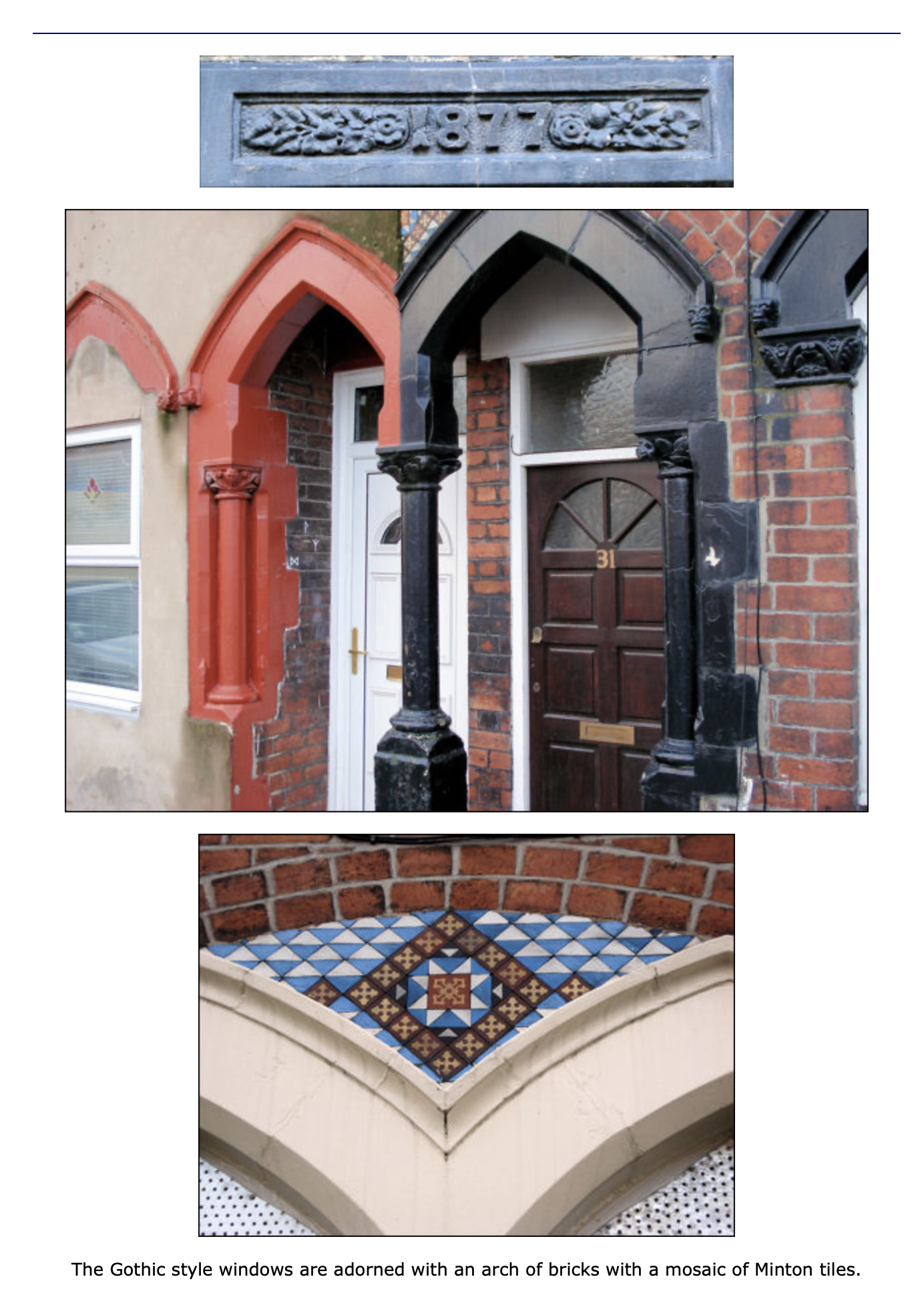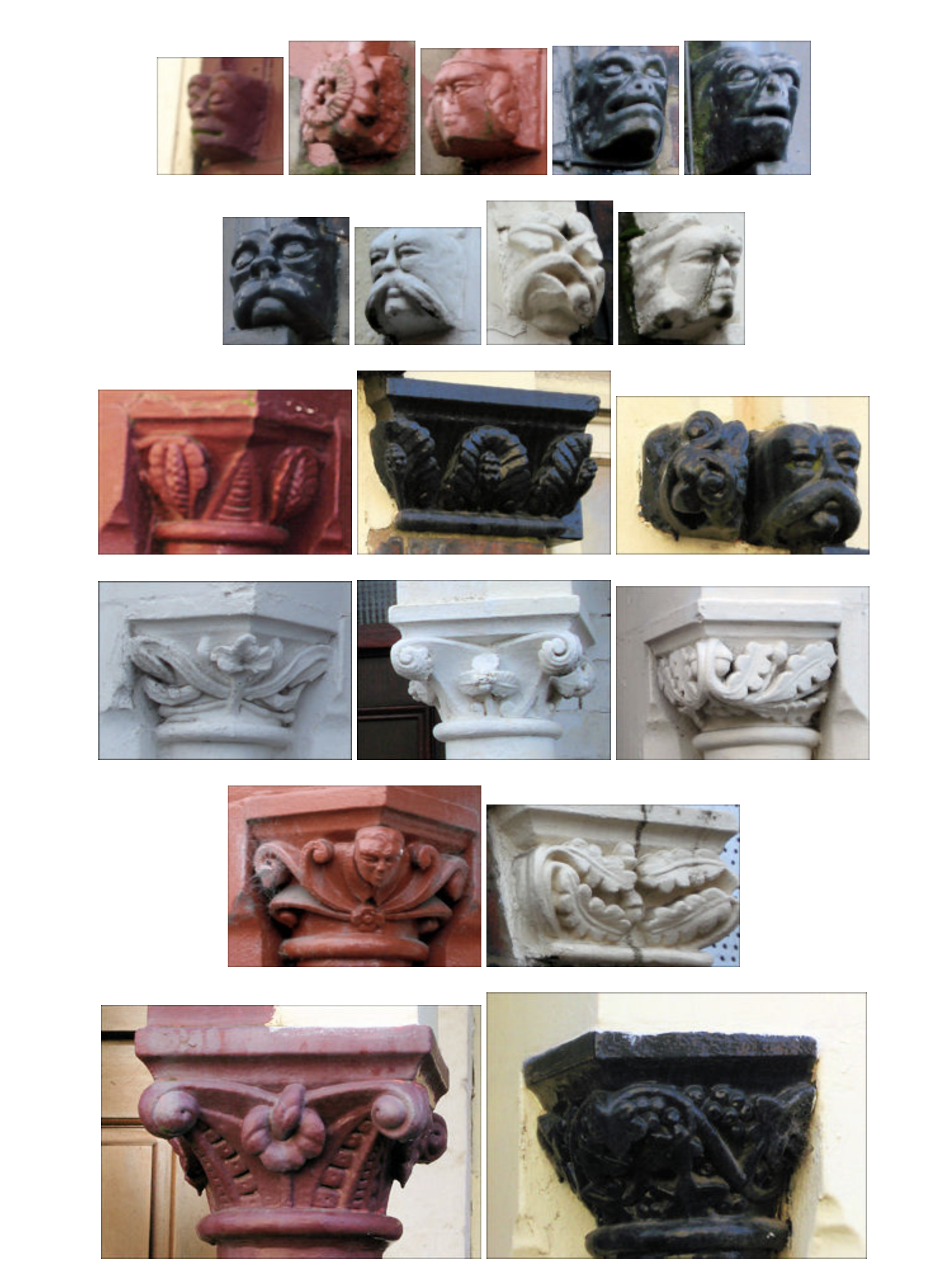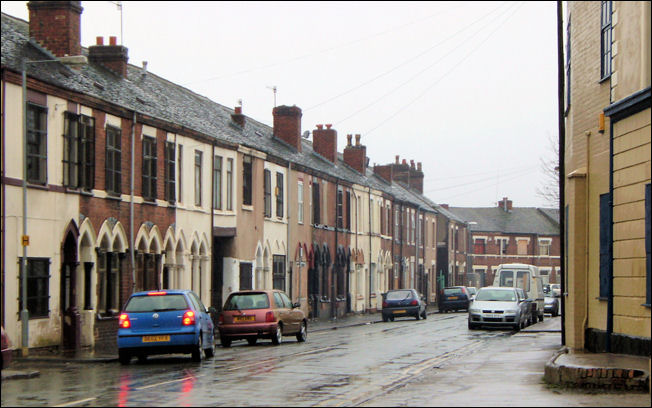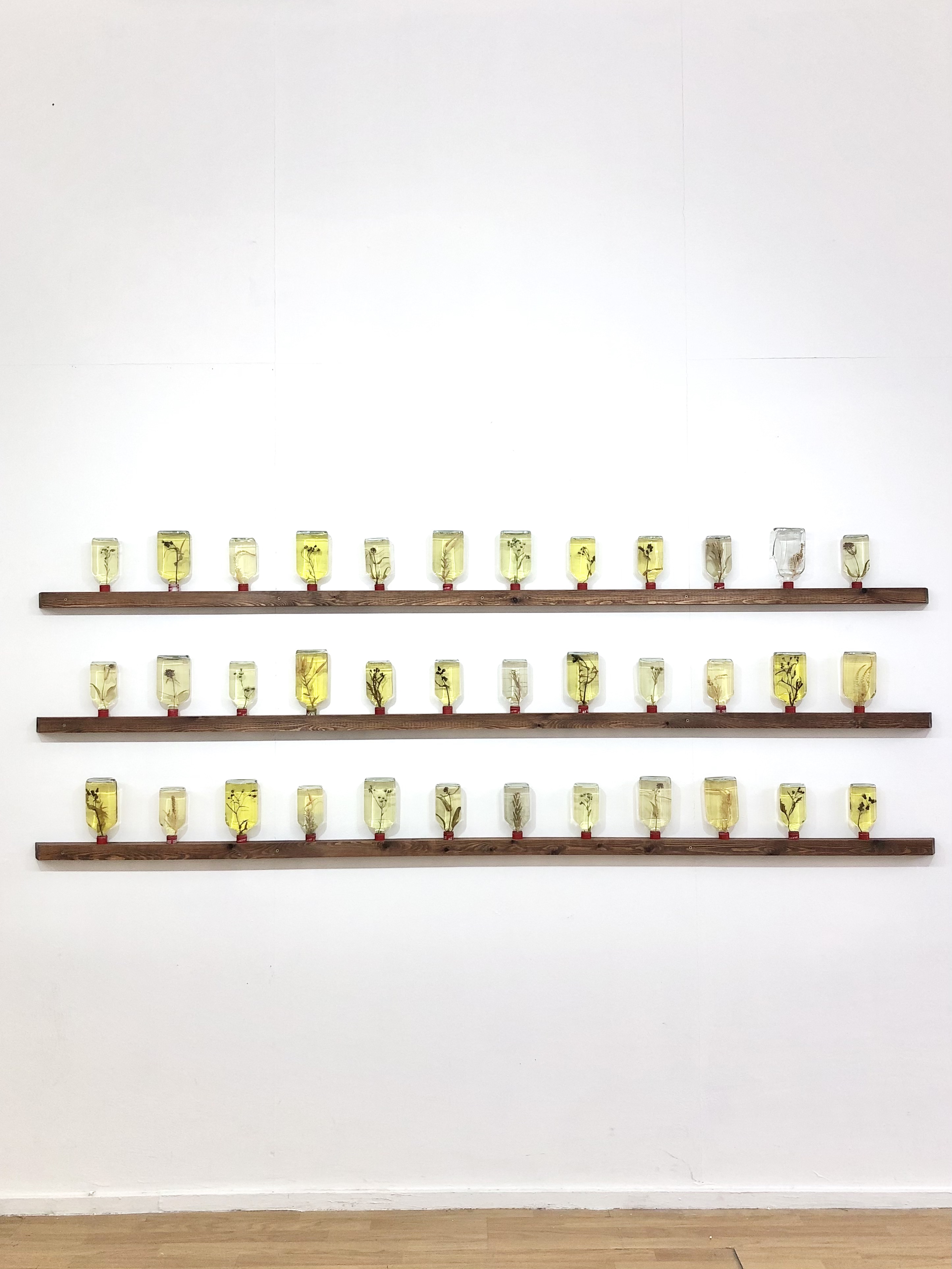A PARTICIPATORY RESIDENCY & EXHIBITION BY DANNY TREACY COLLECTIVE TERRITORIES

Collective Territories was a residency by Danny Treacy at AirSpace Gallery, which run between May and October 2020. The artist residency on-site was preceded by a period of communication with a group of researches in Stoke-on-Trent, introducing him remotely to places of personal significance. As one of the participants, I had a chance to introduce Danny Treacy to the work I’ve been doing at a small brownfield site at Pyenest Street in Shelton, Stoke-on-Trent. It was a fruitful exchange, which informed both the artist’s final work as well as my own.
ON-SITE RESIDENCY & EXHIBITION : COLLECTIVE TERRITORIES [CITY]
During the on-site residency in September, I had an opportunity to share my knowledge of plants and assist Dany in creating one of his exhibition pieces, consisting of 36 Glen’s Vodka bottles of preserved plants. The bottles have been carefully collected by the artist on a large brownfield site in the centre of Hanley – evidence of human activity usually considered ‘inappropriate’. They were then filled with alcohol and plants, which I collected with him on the same site. Most of these plants are considered ‘weeds’ and not unlike the vodka bottles are often seen as unwelcome, plant litter.
![]()
![]()
![]()
![]()
RESIDENCY PARTICIPATION
Prior to Danny’s coming to Stoke, our exchange was focused on a small site in Shelton, which has been the subject of my study since April 2020. It consisted of photographs, observations, book references and maps – which turned out to be a particularly useful tool throughout the residency. Danny’s responses to the information from all the participants were recorded on AirSpace blog.
PYENEST STREET
![]() This small site is situated between Pyenest Street and Shelton New Road in Stoke-on-Trent. It’s a former estate of late Victorian terrace type houses to the north of the Caldon Canal, demolished between 2008 and 2010. This is how Don Barnes, a former resident, describes the area: “There were some forty families living there, the names of most I still remember to this day, two shops, a mill, a motorcycle repair garage, a corn and feed merchant, a motorcycle shop and petrol pumps, a small pottery, the Borough yard where the councils road men worked from, and finally a wholesale garage supplier: all this in about 400 yards.” The houses on Pyenest street had quite unique architectural features – Gothic style windows adorned mosaics of Minton tiles, of which some can be seen on the photos below:
This small site is situated between Pyenest Street and Shelton New Road in Stoke-on-Trent. It’s a former estate of late Victorian terrace type houses to the north of the Caldon Canal, demolished between 2008 and 2010. This is how Don Barnes, a former resident, describes the area: “There were some forty families living there, the names of most I still remember to this day, two shops, a mill, a motorcycle repair garage, a corn and feed merchant, a motorcycle shop and petrol pumps, a small pottery, the Borough yard where the councils road men worked from, and finally a wholesale garage supplier: all this in about 400 yards.” The houses on Pyenest street had quite unique architectural features – Gothic style windows adorned mosaics of Minton tiles, of which some can be seen on the photos below:
![]()
![]()
![]()
My individual interest with the site came with finding a seemingly dead fennel plant in the western part of it. I pruned it and tended to it throughout the spring and summer – a majestic, fragrant plant which kept feeding me till the late autumn. More plant discoveries followed, and I realised that the Pyenest Street site is full of edible plants.
GARDEN ESCAPES & TAXI DRIVERS
In our collaboration during the residency, Danny and I focused on different aspects of the site – whereas I was exploring its flora, he was interested in the human element and the community which uses it. Widespread litter (especially laughing gas bottles), traces of rough sleepers activity, the use of the street by taxi and Uber drivers for convenient temporary parking were the things which drew him to the place. Through conversation, we found meeting points – he introduced me to the idea of ‘garden escapes’, plants which find their way into the wild from closed spaces of human cultivation. I responded by creating a herbarium of ‘garden escapes’ from the site – fennel, oriental poppies, sweet peas and others, which he chose to exhibit alongside his work in the residency exhibition. He in turn went out to Pyenest Street and collected plants to present to taxi drivers stationed there, and through photogrammetry constructed 3D images of their hands holding the specimen they were most drawn to.
RECIPES
There was another, simpler element to this exchange. As a part of my exploration of the edibles from Pyenest Street, I cooked and preserved with collected plants, recorded the recipes and shared them with Danny. The foods that were easily preservable – fennel pickles and olive oil, berry jam and elderflower cordial – I also sent to him to feel and enjoy in London, so that he could have a sense of Pyenest Street before coming to Stoke.
ON-SITE RESIDENCY & EXHIBITION : COLLECTIVE TERRITORIES [CITY]
During the on-site residency in September, I had an opportunity to share my knowledge of plants and assist Dany in creating one of his exhibition pieces, consisting of 36 Glen’s Vodka bottles of preserved plants. The bottles have been carefully collected by the artist on a large brownfield site in the centre of Hanley – evidence of human activity usually considered ‘inappropriate’. They were then filled with alcohol and plants, which I collected with him on the same site. Most of these plants are considered ‘weeds’ and not unlike the vodka bottles are often seen as unwelcome, plant litter.

RESIDENCY PARTICIPATION
Prior to Danny’s coming to Stoke, our exchange was focused on a small site in Shelton, which has been the subject of my study since April 2020. It consisted of photographs, observations, book references and maps – which turned out to be a particularly useful tool throughout the residency. Danny’s responses to the information from all the participants were recorded on AirSpace blog.
PYENEST STREET
 This small site is situated between Pyenest Street and Shelton New Road in Stoke-on-Trent. It’s a former estate of late Victorian terrace type houses to the north of the Caldon Canal, demolished between 2008 and 2010. This is how Don Barnes, a former resident, describes the area: “There were some forty families living there, the names of most I still remember to this day, two shops, a mill, a motorcycle repair garage, a corn and feed merchant, a motorcycle shop and petrol pumps, a small pottery, the Borough yard where the councils road men worked from, and finally a wholesale garage supplier: all this in about 400 yards.” The houses on Pyenest street had quite unique architectural features – Gothic style windows adorned mosaics of Minton tiles, of which some can be seen on the photos below:
This small site is situated between Pyenest Street and Shelton New Road in Stoke-on-Trent. It’s a former estate of late Victorian terrace type houses to the north of the Caldon Canal, demolished between 2008 and 2010. This is how Don Barnes, a former resident, describes the area: “There were some forty families living there, the names of most I still remember to this day, two shops, a mill, a motorcycle repair garage, a corn and feed merchant, a motorcycle shop and petrol pumps, a small pottery, the Borough yard where the councils road men worked from, and finally a wholesale garage supplier: all this in about 400 yards.” The houses on Pyenest street had quite unique architectural features – Gothic style windows adorned mosaics of Minton tiles, of which some can be seen on the photos below:


My individual interest with the site came with finding a seemingly dead fennel plant in the western part of it. I pruned it and tended to it throughout the spring and summer – a majestic, fragrant plant which kept feeding me till the late autumn. More plant discoveries followed, and I realised that the Pyenest Street site is full of edible plants.
GARDEN ESCAPES & TAXI DRIVERS
In our collaboration during the residency, Danny and I focused on different aspects of the site – whereas I was exploring its flora, he was interested in the human element and the community which uses it. Widespread litter (especially laughing gas bottles), traces of rough sleepers activity, the use of the street by taxi and Uber drivers for convenient temporary parking were the things which drew him to the place. Through conversation, we found meeting points – he introduced me to the idea of ‘garden escapes’, plants which find their way into the wild from closed spaces of human cultivation. I responded by creating a herbarium of ‘garden escapes’ from the site – fennel, oriental poppies, sweet peas and others, which he chose to exhibit alongside his work in the residency exhibition. He in turn went out to Pyenest Street and collected plants to present to taxi drivers stationed there, and through photogrammetry constructed 3D images of their hands holding the specimen they were most drawn to.
RECIPES
There was another, simpler element to this exchange. As a part of my exploration of the edibles from Pyenest Street, I cooked and preserved with collected plants, recorded the recipes and shared them with Danny. The foods that were easily preservable – fennel pickles and olive oil, berry jam and elderflower cordial – I also sent to him to feel and enjoy in London, so that he could have a sense of Pyenest Street before coming to Stoke.

